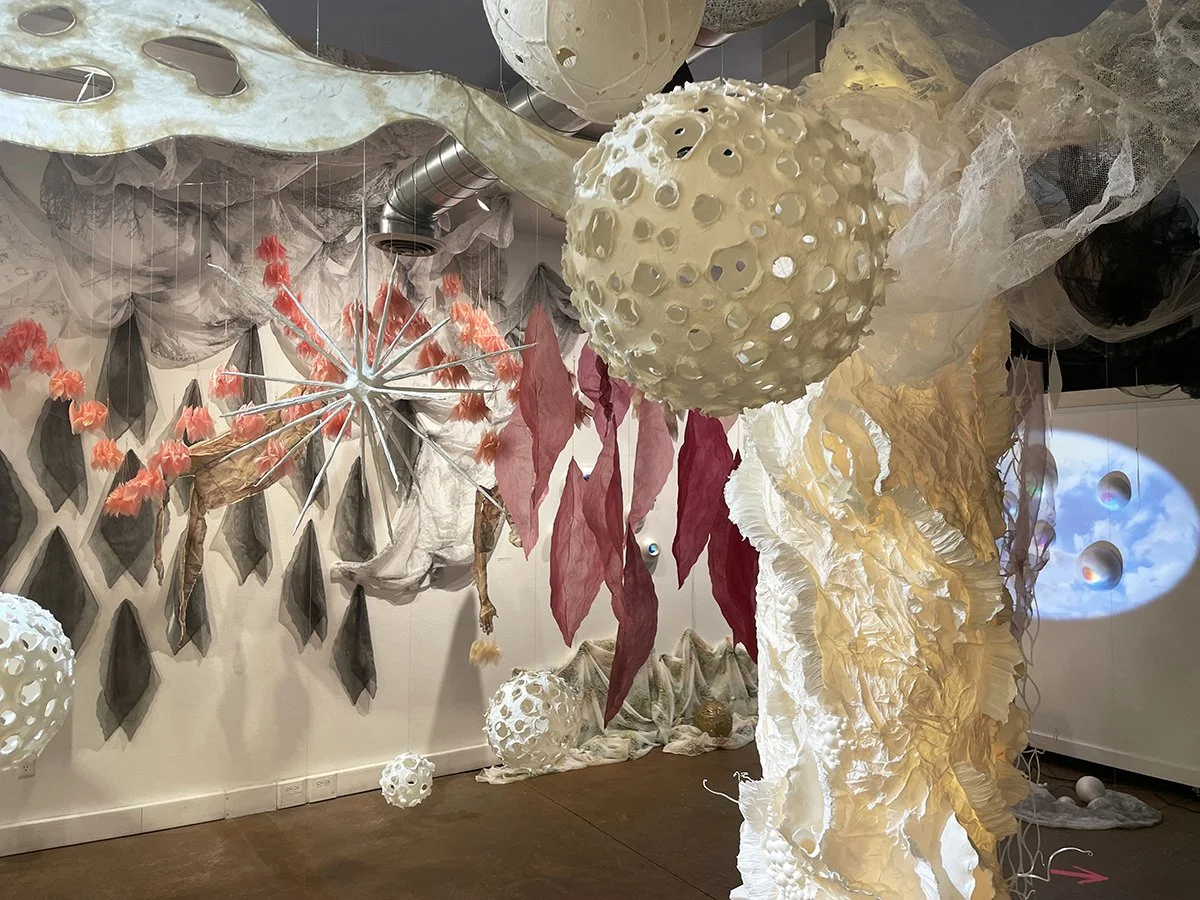CATALYST
CATALYST
Niza Knoll Gallery
915 Santa Fe Drive
Denver, CO 80204
September 24-November 21, 2021
Admission: $5 suggested donation
Review by Laura I. Miller
When the COVID-19 pandemic hit the U.S. in early 2020, Niza Knoll of Denver’s Niza Knoll Gallery had just asked mixed-media artist Jennifer Ghormley if she’d be interested in producing an immersive show. Fast forward to September 2021 when CATALYST—an immersive art exhibit created by five local artists—has transformed the Niza Knoll Gallery into a playful, multi-sensory experience that combines art and technology.
I spoke with one of the artists, Victoria Eubanks, when I visited the exhibition to get her take on the popularity of immersive exhibitions. She said that immersive experiences make memories; i.e. they implant more securely into the viewer’s mind. This seems true to me, as I recall more readily the experience of art unleashed from its framing devices and spilling out into a room. After many months without in-person exhibitions, I was eager to have my senses enveloped by artwork, and this exhibition doesn’t disappoint.
Kendra Fleischman, CATALYST, 2021, video projection, acrylic forms, and fabric. Image by DARIA.
Kendra Fleischman, CATALYST, 2021, videos, acrylic forms, and fabric. Image by DARIA.
CATALYST takes the viewer on a multimedia experience through five zones—one for each artist—which flow together with the aid of gossamer fabrics and paper sculptures. Sculptor Kendra Fleischman designed the first zone, which combines video projections of the sky and swirling geometric figures with rounded, ivory sculptures that resemble pearls when the videos are projected onto them, or portals when the videos exist inside of them. Fleischman’s combination of images of the natural world and technology create an atmosphere of innovation and possibility.
Judy Gardner, CATALYST, 2021, 3-D printed and laser-cut plastic and laser-cut wood. Image by DARIA.
A detail image of Judy Gardner, CATALYST, 2021, 3-D printed and laser-cut plastic and laser-cut wood. Image by DARIA.
The second zone, designed by artist Judy Gardner, is the darkest zone, with Gardner’s 3D-printed and laser-cut sculptures surrounded by a black backdrop that extends up to the ceiling. Whereas Fleischman’s zone recollects the sky, Gardner’s imitates an underwater landscape with jellyfish-, seaweed-, and coral-like structures that appear to float against the black. Like the previous zone, this area, too, invites the viewer to rethink what’s possible with digital technology and encourages her to see anew the plants and creatures that lurk below the surface.
Bonnie Ferrill Roman, CATALYST, 2021, handmade paper, wood, LED lights, and fabric. Image by DARIA.
A detail image of Bonnie Ferrill Roman, CATALYST, 2021, handmade paper, wood, LED lights, and fabric. Image by Laura I. Miller.
In the third zone, sculptor Bonnie Ferrill Roman’s handmade paper spheres, branches, and tubes resemble a wintry forest where seeds and spores float and intermingle. This zone could also be said to resemble an alternate universe, with cratered paper moons and pod-like alien creatures. Either way, this area teems with simulated life that spills over into the adjoining zones and binds them together.
Victoria Eubanks, CATALYST, 2021, glassine fabric and encaustic paintings. Image by DARIA.
A detail image of Victoria Eubanks, CATALYST, 2021, glassine fabric and encaustic paintings. Image by DARIA.
Victoria Eubanks’ zone combines panels of dyed glassine fabric with patterned encaustic (made from beeswax, tree sap, and pigment) paintings that wallpaper the room’s beams. The fabric panels hang from the ceiling in groups of three to create prisms. Additional fabrics visible inside the prisms create a kaleidoscopic effect, while the large scale of the panels—from floor to ceiling—and the dyed patterns—ranging from birds to rainbows—bring to mind a festival of kites. With its playful airiness, this installation tempts the viewer to engage with the work, to wrap herself in fabric and twirl about the space, but touching is of course prohibited.
Jennifer Ghormley, CATALYST, 2021, fabric and thread. Image by Laura I. Miller.
Jennifer Ghormley, CATALYST, 2021, fabric and thread. Image by DARIA.
In the final zone, multimedia artist Jennifer Ghormley’s work connects all five zones with floating peach- and maroon-colored fabrics that traverse the width of the gallery. She contrasts the pink and red hues with black and gray fabrics suspended on the wall, perhaps symbolizing the relationship between life and death. Ghormley’s installation is the only one to feature full human-like figures, which hang ghostlike from the ceiling as if they’re passing through to the afterworld.
For a small exhibition that features five different artists, CATALYST has a surprising amount of unity. The artists’ use of repetition in colors, patterns, shapes, materials, and mediums creates cohesion without being too predictable. Even though the artists repurposed many of the materials from previous exhibitions, it’s clear that they worked together and had a strong vision for how they wanted the viewer to experience the show: a catalyst for new ways of thinking and viewing the world.
Laura I. Miller is a Denver-based writer and editor. Her reviews and short stories appear widely. She received an MFA in creative writing from the University of Arizona.

















